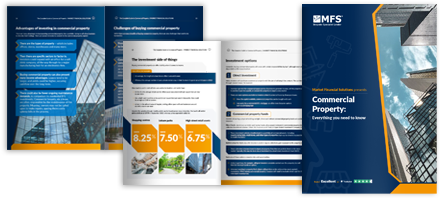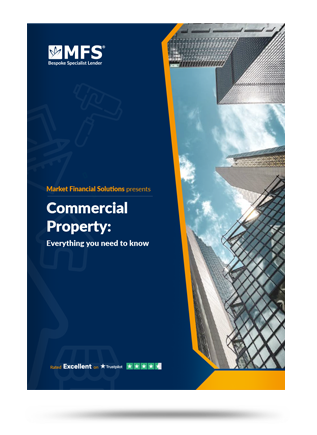Disclaimer
MFS are a bridging loan and buy-to-let mortgage provider, not financial advisors. Therefore, Investors are encouraged to seek professional advice.
The information in this content is correct at time of writing.

Energy Performance Certificates (EPC) are an important piece of the property puzzle. But what is the minimum EPC rating for commercial property, and why should investors care?
In a nutshell, EPCs indicate how energy efficient a building is and give it a rating. Buildings will be ranked from G (inefficient) to A (very efficient). These ratings will show how costly powering the property could be and how high its carbon emissions may reach.
EPCs are needed whenever a residential property is built, sold, or rented and they are valid for 10 years from the date of issue[1]. Although, there are some instances where an EPC is not required. For commercial investors, this includes:
- industrial sites, workshops and non-residential agricultural buildings that do not use a lot of energy
- holiday accommodation that’s rented out for less than 4 months a year or is let under a licence to occupy
- stand-alone buildings with total useful floor space of less than 50 square metres
The certificates are produced by approved domestic energy assessors[2], who will highlight what changes could be made to a property to make it more efficient.
Commercial EPC ratings explained
Currently, there are commercial EPC [3]requirements for property owners who rent out or sell their business premises. The certificate will also be needed where buildings under construction are finished or; where there are changes to the number of parts used for separate occupation and these changes involve providing or extending fixed heating, air conditioning or mechanical ventilation systems.
Although, there are certain exemptions in place. An EPC is not required for commercial property if the owner can demonstrate:
- that the building is listed or officially protected and the minimum energy performance requirements would unacceptably alter it
- it’s a temporary building that will only be used for 2 years or less
- the building is used as a place of worship or for other religious activities
- it is an industrial site, workshop or non-residential agricultural building that doesn’t use much energy
- it’s a detached building with a total floor space under 50 square metres
- the building is due to be demolished by the seller or landlord and they have all the relevant planning and conservation consents
There are also exemptions in place for certain vacant commercial properties, and demolition plans. What’s more, if property investors feel they have been unfairly fined for not having an EPC available, they may be able to appeal the charge.
Currently, Minimum Energy Efficiency Standards (MEES) require that rented commercial properties have a minimum EPC rating of E[4]. From 2028, this minimum rating will be raised to C for commercial landlords, which is then set to hit B by 2030[5].
What is the minimum EPC rating for commercial property going to be?
Landlords will not be able to continue with an existing tenancy if the EPC is below an E ranking[6]. Under current plans, a C rating will be needed by 2028 and B will be the minimum from 2030.
The Government estimates this will eventually cover around 85%[7] of the UK’s non-domestic rented stock. These implementations are likely to be needed through two “compliance windows”, where EPC documentation will be required at various points between 2025 and 2030. Although, with MEES regulation recently pushed back, commercial landlords should seek guidance on whether these windows will also be moved.
Substantial fines will be issued on those who fall foul of the rules. The most serious breaches could have fines of up to £150,000 levied[8]. Non-complying landlords may also be “named and shamed” on a public register. Worryingly, investors across the UK could be underestimating the likelihood of these costs too.
The Government estimated around 18% of commercial properties were in the F and G EPC brackets in 2022[9]. Also, recent research from Knight Frank found that 80% of regional offices occupied by leading UK-listed companies will fall short of the EPC standards required by 2030[10]. Therefore, it’s important to know what the minimum EPC rating for commercial property is for the sake of budgeting, and preparation.
Property owners will want to act quickly on upgrading their commercial lots, given how costly the investments could be. In hitting the 2030 minimums, the cost to the UK’s industrial, manufacturing, logistics and warehousing property stock is expected to reach £30bn, according to Avison Young[11].

How to improve your EPC rating – commercial property & residential homes
Fortunately, there are many options available to landlords to meet commercial EPC requirements and improve the EPC rating for commercial properties and residential homes alike. A good place to start with is insulation.
Poor insulation can be a major cause of energy loss. Especially for commercial spaces such as warehouses which tend to have large roofs and wall surface areas. This can be amended through upgraded cladding or refurbishment works which, initially, may prove expensive, but should be offset by lower energy bills.
Additional upgrades can also include better heating, venting and air conditioning systems. Energy efficient lighting upgraded glazing or investment in solar panels can all pay off down the line. A lot of planning may be needed for these upgrades, but there is plenty of support out there to help investors carry the burden.
Investors who are still unsure of what the minimum EPC rating for commercial property is, or of what they need to do moving forward can turn to public entities for guidance. The Carbon Trust offers independent advice on efficient energy usage for businesses and the installing of renewable energy sources. The Energy Savings Trust also has example case studies of best practices, along with other energy efficiency resources and events.
There are also a range of Government schemes which offer loans, grants, or subsidised energy-saving measures to support small businesses[12]. An example includes the SME Energy Efficiency Scheme (SMEES[13]), where grants of up to £100,000 are available to help businesses improve their energy efficiency.
Also, MFS can provide investors with flexible bridging loans in as little as 3 days, if they need fast finance for renovation or refurbishment plans.
Why should you care?
So, investors may be aware of the EPC rating for their commercial property, but is there any tangible reason to care? Even without the legislative backdrop, property owners could benefit from embracing environmental upgrades on their own initiative. Greener property may result in higher returns and/or lower costs.
Though is it possible to sell a commercial property with an EPC rating of G, investors will need to disclose it[14]. They might also be asked to make improvements to increase the property’s rating before selling it. So, if an investor’s commercial property has an EPC rating above G, they might have better chances to sell it or rent it out.
Improvements made to get higher EPC ratings and meet commercial EPC requirements could eventually result in higher rents, boosting revenues for owners and landlords. More efficient buildings could also cut utility costs and unexpected headaches. A new boiler may be less likely to break down than one decades old, for example.
Environmentally efficient commercial property could also hold a premium in the market. In the residential sector, renters highlighted they’d be willing to pay more for greener homes[15], while sustainable property has emerged as a top priority for Generation Z [16]buyers.
In the commercial world, demand is rising for green offices among UK landlords[17]. What’s more, plenty of property investors are set to branch out into new sectors over the coming years[18].
The Complete
Commercial Property Guide
Everything you need to know
- Extensive introduction
- Lease types
- Regulations & responsibilities
- Finance
[1] https://www.gov.uk/selling-a-home/energy-performance-certificates
[2] https://nationalcareers.service.gov.uk/job-profiles/domestic-energy-assessor
[3] https://www.gov.uk/energy-performance-certificate-commercial-property
[4] https://cfpgreenbuildings.com/news-and-cases/sustainability-and-the-built-environment-regulatory-landscape-in-the-united-kingdom-for-2024/
[5] https://energyadvicehub.org/mees-regulations-for-commercial-properties-delayed-to-2028/#:~:text=Minimum%20Energy%20Efficiency%20Standard%20deadline,of%20C%20for%20their%20properties.
[6] https://propertyindustryeye.com/three-quarters-of-belfast-offices-unusable-by-2030-cbre/
[7] https://www.nelsonslaw.co.uk/epc-b-2030/
[8] https://epchome.co.uk/commercial-epc-energy-ratings/
[9] https://www.landlordzone.co.uk/news/commercial-property-energy-upgrades-could-cost-over-30bn
[10] https://www.knightfrank.co.uk/blog/2024/02/01/what-impact-does-esg-regulation-have-on-business-rates
[11] https://www.propertyweek.com/analysis/upgrading-stock-to-mees-could-reach-305bn/5118975.article
[12] https://www.ofgem.gov.uk/information-consumers/energy-advice-businesses/find-business-energy-efficiency-grants-and-schemes
[13] https://www.gov.uk/business-finance-support/sme-energy-efficiency-scheme-smees
[14] https://epchome.co.uk/commercial-epc-energy-ratings/
[15] https://www.propertyreporter.co.uk/landlords/majority-of-renters-say-they-would-pay-more-for-a-greener-home.html
[16] https://www.buyassociationgroup.com/en-gb/2022/06/24/sustainable-property-gen-z/
[17] https://www.reuters.com/world/uk/uk-landlords-bet-green-offices-hybrid-work-makes-tenants-picky-2024-03-28/
[18] https://www.commercialtrust.co.uk/news/positive-forecast-for-commercial-property/











